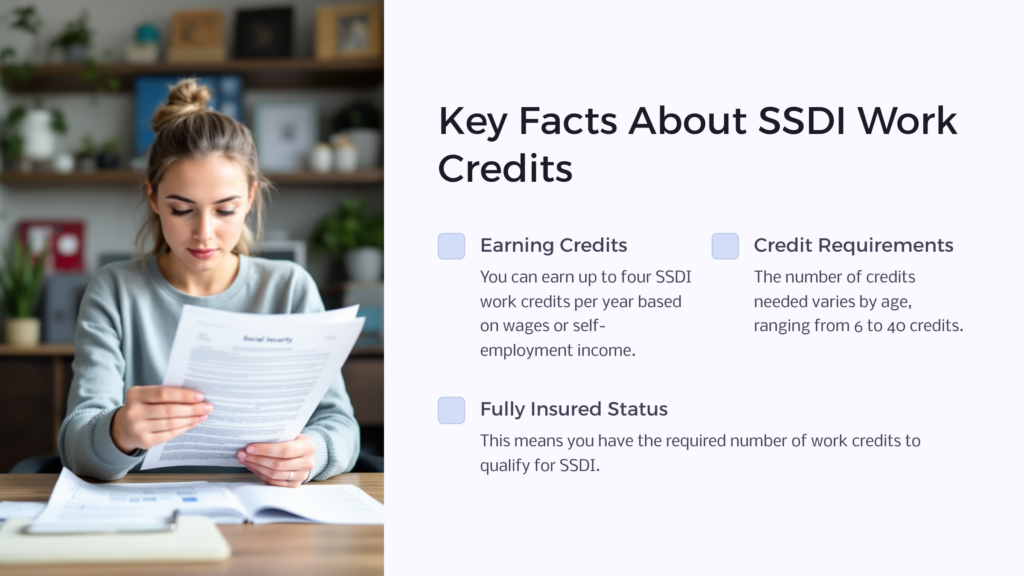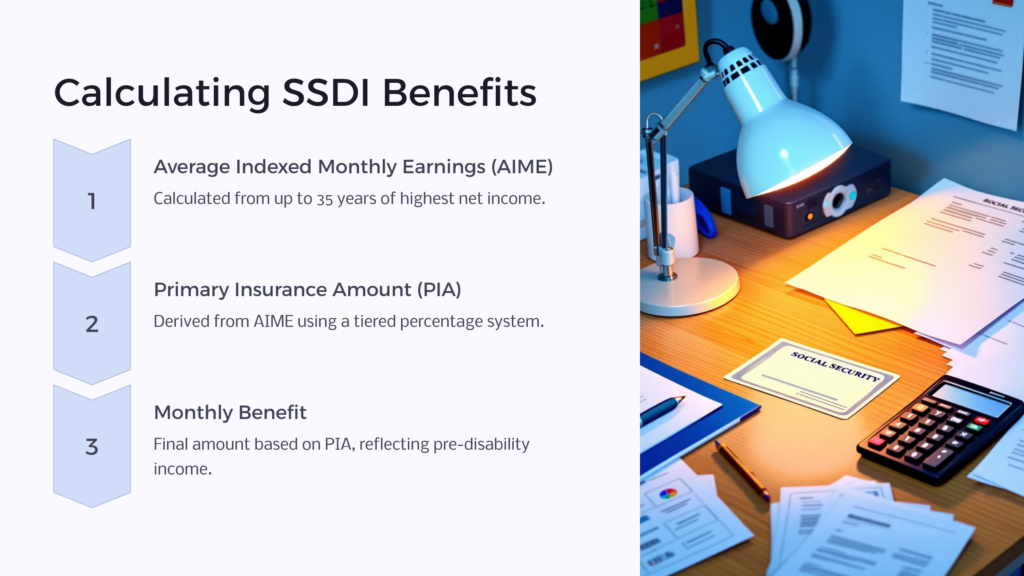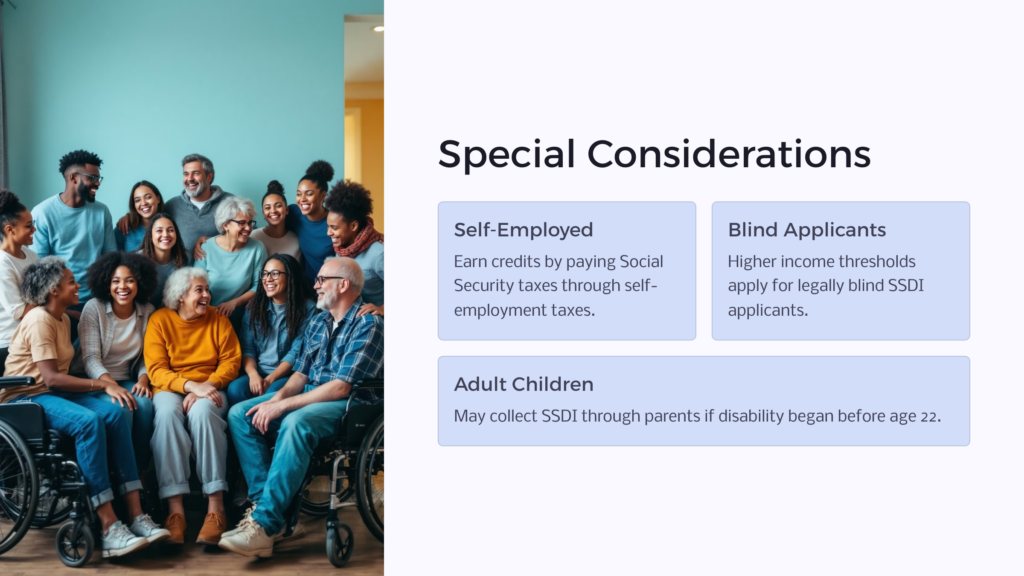SSDI work credits are used to calculate whether an individual is eligible to receive Social Security Disability Insurance benefits. These credits are based on work history, which, when factored together with age and lifetime earnings, will determine the amount of SSDI benefits an individual can collect every month.

Important Facts About SSDI Work Credits
- What are SSDI work credits?
- How many work credits do I need?
- How many work credits can I earn per year?
- What does “fully insured” status mean?
- Can I buy SSDI work credits?
- What happens if I’m disabled but don’t have enough work credits?
- How do I earn work credits if I’m self-employed?
- How to check your SSDI work credits?
- Are work credits required for SSI disability payments?
The Social Security Administration is responsible for administering public benefits like SSDI and SSI. Veterans Benefits, while similar, are issued by the VA or Department of Veterans Affairs. While SSI (Supplemental Security Income) is issued to individuals of limited economic means (such as individuals who are blind, disabled, elderly, or have little income), eligibility for SSDI hinges on previous work history.
To qualify for SSDI, an applicant must both prove that they are disabled according to the definitions laid out by the SSA, and have earned enough SSDI work credits based on their work history. If those criteria are met, then the SSA will issue an award letter stating the amount of monthly benefits the SSDI recipient can expect to receive, along with any indication of SSDI back pay that would have accrued during the wait time for the application to get approved.

Once you are approved for SSDI, your monthly benefit amount will be calculated using an Average Indexed Monthly Earnings (AIME) to find a Primary Insurance Amount (PIA). The AIME is found by adding up all your income from up to 35 years of your highest net income earned, then dividing that number by 35, and then again by 12. As of 2020, your PIA amount will be derived by taking 90% from the first $960 of your AIME, 32% from anything over $960 but under $5,785, and 15% of anything over $5,785. This final amount will be the maximum SSDI monthly payment you can collect.
As you can see, the maximum SSDI amount you can collect is based on the percentage of your best income performance before becoming disabled, so for some individuals, this can become a decently sizable amount. Remember that SSDI is meant to provide cash assistance for individuals who can no longer work due to their disability, so in this way, the SSDI payments will need to reflect their income.
Here are some important questions to ask about SSDI work credits and SSDI benefits.
What are SSDI work credits?
SSDI work credits are credits earned toward your eligibility to receive SSDI benefits. These credits are earned based on total yearly wages or self-employment income. Note that these wages or income must have been subjected to Social Security Taxes in order to earn an SSDI work credit. As of 2020, earning even just $1,410 in wages or income would garner you one SSDI work credit. Earning just $5, 640 would earn you the maximum four annual credits.
How many work credits do I need?
This depends on your age when becoming disabled and applying for SSDI. If your age falls between 31 and 42, you will need 20 credits. If you become disabled in your forties, you will generally need 22-28 credits. If you become disabled in your fifties, you will need up to 38 credits. And if you are 62 or older, 40 credits is the requirement. In most cases, half of those credits will need to have been earned in the past decade of actively working.
How many work credits can I earn per year?
You can earn up to four SSDI work credits per year. However, in most cases, working individuals will most likely be earning that amount. Considering that the eligibility requirement for earning four SSDI work credits is just $5,640 or just $470 monthly, even individuals with limited income can earn enough work credits.
Keep in mind that if you are earning more than $1,260 per month or $2,110 per month as a blind individual, the SSA considers that substantial gainful activity. It’s an indication that your disability is not sufficient enough to impede your ability to provide yourself; therefore, you would not be eligible to collect a monthly Social Security disability benefit.
What does “fully insured” status mean?
The state of being fully insured vis-a-vis potentially collecting SSDI means that you have the requisite number of SSDI work credits under your proverbial belt. Remember that SSDI stands for Social Security Disability Insurance, and it is a sort of taxpayer-funded insurance policy to protect individuals who can no longer work due to their disability. Their insurance premium is not made by making a cash payment to the government, but rather by actively participating in the workforce and meeting certain income thresholds, while also contributing to Social Security Taxes. That said, you’re insured status is active if you are meeting the SSA requirements vis-a-vis requisite work credits.
Can I buy SSDI work credits?
No, you cannot buy SSDI work credits. Credits are earned based on a work history of earning wages or self-employment whereby you have contributed tax payments to Social Security. But despite that contribution, SSDI does not depend on your monetary contribution, but rather earning a requisite number of work credits. You can only earn these SSDI work credits by working.
What happens if I’m disabled but don’t have enough work credits?
You don’t always need 40, 30, or even 20 credits to qualify for SSDI. A younger worker under the age of 24 will generally only need 6 SSDI work credits, which roughly equates to 1.5 years of work. If you become disabled and don’t have the requisite number of work credits needed to collect SSDI, you might also consider applying for SSI, or Supplemental Security Income, which is not based on work history but rather financial need.
How do I earn work credits if I’m self-employed?
 It’s as simple as paying Social Security taxes through your self employment taxes. Generally speaking, these Social Security taxes are around 12% for self-employed individuals, since they will be shouldering both the “employee” and “employer” responsibilities in terms of paying taxes. By contrast, wage earners usually have 6% of their paycheck deducted, while the employer pays the other 6%. However, the amount you pay if you are self employed will depend on your net income and other factors such as the way our business is structured.
It’s as simple as paying Social Security taxes through your self employment taxes. Generally speaking, these Social Security taxes are around 12% for self-employed individuals, since they will be shouldering both the “employee” and “employer” responsibilities in terms of paying taxes. By contrast, wage earners usually have 6% of their paycheck deducted, while the employer pays the other 6%. However, the amount you pay if you are self employed will depend on your net income and other factors such as the way our business is structured.
How do I check my SSDI work credits?
You will need to check the table on the Department of Social Security Website to see how many credits you need based on your age. If you have been gainfully employed until your disability and making over $5, 640 annually within the past decade, you should have enough SSDI work credits to apply. If you don’t, that will be indicated in a Social Security Denial Letter, which you are then allowed to contest should you feel the decision made by the SSA has been in error.
How do I find out if I’m insured?
If you are disabled, the best way to find out if you are insured for disability benefits is to file a disability claim with the Social Security Administration (SSA) to get a formal decision. When you apply, provide proof of your current year’s and prior year’s earnings so that they can be considered in determining your insured status. If you are not disabled or would like a preview, you can review the earnings statement that the Social Security Administration has made available to you online at www.ssa.gov. Just set up a My Social Security account and request an earnings statement (to be distinguished from a benefit statement).
If you do not have access to the Internet, you can visit a Social Security office to get the statement. The earnings statement shows your total earnings by year and tells whether you were insured for disability benefits at the time you access the notice. If the statement shows you are insured, retirement and disability benefit projections will also be given. Note, however, that the statement will not include your current year’s earnings and sometimes your prior year’s work. Accordingly, you might be insured even if the statement says that you are not.
Missing Earnings
Although not common, some of your work may be missing from the statement. If so and you can prove the number of your earnings and that Social Security taxes were paid on the earnings, you can get your earnings record corrected. Accordingly, it’s always a good idea to periodically compare your W-2s and self-employment tax returns with the itemization of earnings on the statement to be sure you are getting credit for all your work. This is important not only for insured status but also because your Social Security Disability and Retirement benefit amounts are based on your earnings.
If you find a discrepancy, contact the Social Security Administration (SSA), preferably by visiting the closest office; or if that is not possible, call 1-800-772-1213 to arrange to submit copies of any proof you have of the missing earnings; however, if the missing wages are from the most recent three years, SSA will investigate to establish those earnings even if you do not have pay stubs or W-2’s as proof.
Proof of Recent Work
When you apply for benefits, it is helpful to take documentation of your recent earnings that may not yet be posted in Social Security’s records. Your prior-year W-2s or self-employment tax returns and proof of any current-year earnings, such as pay stubs or business receipts and expenses, will help Social Security correctly assess whether you have enough work credits to qualify for Social Security Disability.
How does the SSA qualify a disability?
SSDI eligibility is not just based on SSDI work credits alone. In order to collect monthly SSDI benefits, you will also need to prove to the SSA that you meet their definition of disability and that your disability prevents you from being gainfully employed. Payments for partial disability or temporary disability are not covered by the SSA, but rather by worker’s compensation, which is a type of insurance that employers in most states are required to carry.
However, if a disability will prevent someone from doing the work they did before, and the SSA determines this person cannot seek other work because of their condition, and this said disability will last for one year or longer or eventually result in death—then this person can be considered disabled by the SSA.
The SSA will look at several benchmarks regarding your disability to fully vet your eligibility for SSDI benefits, which include a work test:
- Are you earning less than $1,260 per month?
- Is your condition severe enough to limit your ability to perform basic work (standing, sitting, lifting, walking, remembering)?
- Does your disability match any on an extensive list provided by the SSA, or can a compassionate allowance be made for conditions such as ALS or pancreatic cancer?
- Does the disability prevent you from doing the work you did previously?
- Does the disability prevent you from securing new work?
If the answers to these questions are yes, you may qualify for SSDI.
If you feel that the SSA is incorrect in their assessment that you are not a disabled worker, you might consider hiring a disability lawyer to represent your case through the appeals process to secure your disability claim. A Social Security disability attorney can help present your case and attendant documents like medical evidence, should the Social Security work credit component of your application meet the requirements, but the SSA will not approve your Social Security benefits claim.
Are work credits required for SSI disability payments?
Supplemental Security Income (SSI) is a federal, needs-based, public assistance program. Benefits are payable to individuals with limited income and resources who are disabled, including disabled minor children, or who are at least age sixty-five. If no Social Security benefits are available to you, you may still be able to get some financial help by applying to the Social Security Administration (SSA) for SSI disability payments.
Because SSI is paid based on financial need plus age or disability, Social Security will first evaluate your SSI application to see if your family’s income and countable resources (countable assets) fall within SSI’s allowed limits. If a disabled adult lives with his or her spouse, the spouse’s income and resources and the number of dependents the spouse supports are considered in addition to the applicant’s income. Similarly, when a disabled child lives with his or her parents or stepparents, the parental income and resources and the number of dependents the parents support will be considered in determining the disabled child’s financial eligibility.
Once it has been determined that the applicant is financially eligible, the adult’s or child’s medical condition will be reviewed and evaluated to determine whether he or she is disabled under Social Security law. SSI’s definition of disability for adults is the same as the definition of disability for Social Security disability. The definition of disability for a minor child and the process for determining medical eligibility for a child are different from those for an adult. For more information about the adult disability evaluation, please see our collection of articles on the disability claims process. The many articles we offer on SSI provide more information about the financial and child’s disability requirements for Supplemental Security Income eligibility.
Dual Entitlement
Some people with a Social Security benefit of less than $770 may be eligible for a federal SSI payment to supplement their Social Security. The federal supplement will bring the claimant’s total income up to $770 per month. In addition to this, some states pay an optional SSI state supplement.
Special exceptions regarding SSI

SSDI applicants who are legally blind or have low vision benefit from special exemptions around SSDI. For instance, SSDI recipients can still be working when they apply for SSDI if they are not making more than $1,170 per month. But for legally blind and low vision applicants, this threshold may be higher, for instance, as much as $2,100, making it easier for them to collect SSDI.
If a widow or widower is disabled and between the ages of 50 and 60, and their disability began within seven years before the demise of their spouse, they can collect SSDI as well. They may also qualify for other survivor’s benefits, so it’s good to consult with the SSA over the phone.
Adult children over the age of 18 who are no longer in high school can also collect SSDI through their parents if those parents (or parent) also receive SSDI. This child can be any age, if they are unmarried and their disability began before they turned 22. Unlike the SSDI calculation for adults, it is not necessary that they have ever worked, but they must not earn mor
than $1,260 per month if they are working. This arrangement makes it easier for a disabled individual with a disabled child who may need additional medical and care expenses to take care of their family and defray costs.
SSDI Work Credits
The Social Security Administration provides disability benefits, SSI benefits, and retirement benefits from the federal government, funded by FICA taxes. Other benefits, like worker’s compensation and Medicare benefits, are provided at the state level. These federally-sponsored disability payments are administered from a local Social Security office and help Americans continue living comfortably as possible.
In the case of the SSDI disability benefit, disability payments are obtained when an individual has earned enough work credits. For individuals who have been injured on the job, it’s important to look into your state’s policies regarding worker’s compensation for short term relief for workers. But for individuals who face a more debilitating illness or condition, perhaps one that will eventually result in death, SSDI provides a long-term option for defraying living expenses.
 Benefits.com Advisors
Benefits.com Advisors
With expertise spanning local, state, and federal benefit programs, our team is dedicated to guiding individuals towards the perfect program tailored to their unique circumstances.
Rise to the top with Peak Benefits!
Join our Peak Benefits Newsletter for the latest news, resources, and offers on all things government benefits.




















